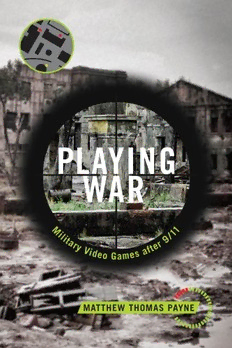
Playing War: Military Video Games After 9/11 PDF
Preview Playing War: Military Video Games After 9/11
Playing War This page intentionally left blank Playing War Military Video Games after 9/11 Matthew Thomas Payne New Y ork Univers ity P ress New York and London NEW YORK UNIVERSITY PRESS New York and London www.nyupress.org © 2016 by New York University All rights reserved References to Internet websites (URLs) were accurate at the time of writing. Neither the author nor New York University Press is responsible for URLs that may have expired or changed since the manuscript was prepared. ISBN: 978-1-4798-4856-0 (hardback) ISBN: 978-1-4798-0522-8 (paperback) For Library of Congress Cataloging-in-Publication data, please contact the Library of Congress. New York University Press books are printed on acid-free paper, and their binding materials are chosen for strength and durability. We strive to use environmentally responsible suppli- ers and materials to the greatest extent possible in publishing our books. Manufactured in the United States of America 10 9 8 7 6 5 4 3 2 1 Also available as an ebook For Sophie & Jackson This page intentionally left blank Contents Acknowledgments ix Introduction: Welcome to Ludic War 1 1. Nintendo War 2.0: Toward a New Modality of Ludic War Play 35 2. The First-Personal Shooter: Narrative Subjectivity and Sacrificial Citizenship in the Modern Warfare Series 69 3. Fighting the Good (Preemptive) Fight: American Exceptionalism in Tom Clancy’s Military Shooters 95 4. Through a Drone, Darkly: Visions of Dystopic Ludic War 116 5. Marketing Military Realism: Selling the Gameplay Modality of Ludic War 145 6. Promotion of Self in Everyday Strife: Gaming Capital of the Ludic Soldier 170 Conclusion: The Ludification of War Culture 201 Notes 213 Gameography 243 Bibliography 247 Index 265 About the Author 273 vii This page intentionally left blank Acknowledgments As I sit down to finally write these acknowledgments, I realize that I’ve been thinking about post-9/11 military shooters for over a decade. More stunning is the realization of just how many wonderful people I’ve met during this time—students and colleagues who have challenged and inspired my thinking on video games, and on what it means to do and to teach critical media studies. My hope is that this project honors our conversations, our debates, and our friendships. Although this book is a far cry from my graduate work, I need to begin by thanking my advisor, Sharon Strover. Without her guidance and support, I would have almost certainly embarked on a more con- ventional research topic. I am also in considerable debt to Michael Kack- man, Kathleen Tyner, Joe Straubhaar, and Dana Cloud for their feedback on the book’s “alpha” build. My colleagues in the College of Commu- nication and Information Sciences at the University of Alabama have likewise been tremendously supportive. Meredith Bagley, Jason Black, Michael Bruce, Dwight Cammeron, Glenda Cantrell, Maya Champion, John Chisholm, Chandra Clark, Nick Corrao, Marylou Cox, Andy Grace, Yonghwan Kim, Elliot Panek, Rachel Raimist, Adam Schwartz, Pam Tran, and Shuhua Zhou have made working in the Telecommu- nication and Film Department an absolute pleasure. Special thanks to Andy Billings, Bill Evans, and Jeremy Butler for allowing me to com- mandeer their office doorways for many unscheduled mentoring ses- sions. As they like to say in these parts: Roll tide. I also want to thank my extended media and game studies networks for their contributions to the ideas in this book, especially Jessica Aldred, Peter Alilunas, Tim Anderson, Ben Aslinger, Manu Aviles-Santiago, Drew Ayers, Kevin Bozelka, Brett Caraway, Alexis Carreiro, Michael Curtin, Sean Duncan, Eric Freedman, Harrison Gish, Jonathan Gray, Hollis Grif- fin, Roy Grundmann, Raiford Guins, Dan Herbert, Jennifer Holt, Derek Johnson, Aynne Kokas, Henry Lowood, Chris Lucas, Nick Marx, William ix
